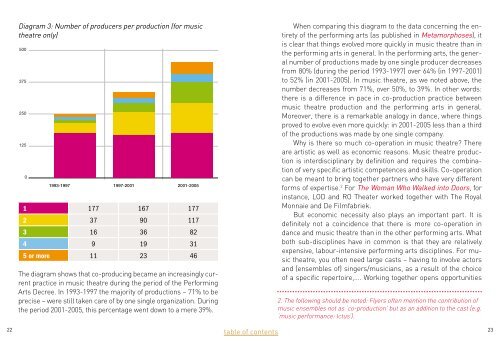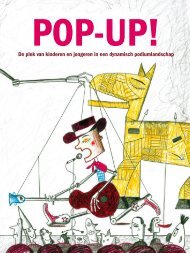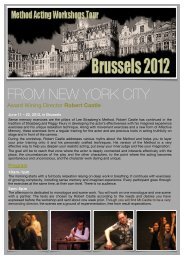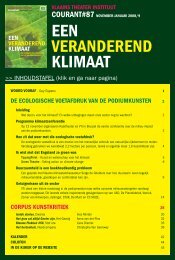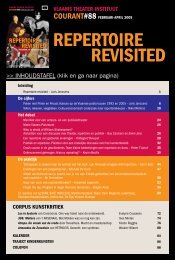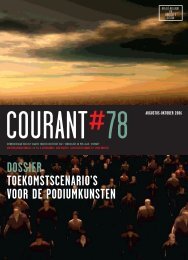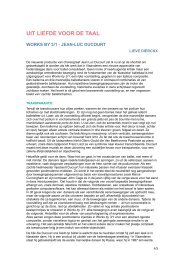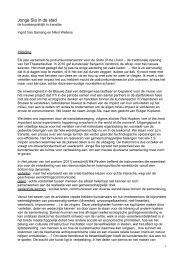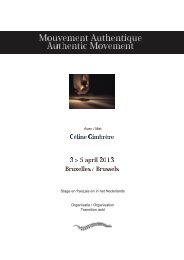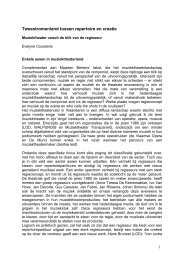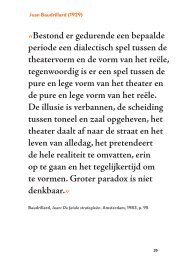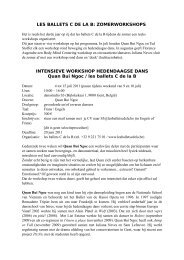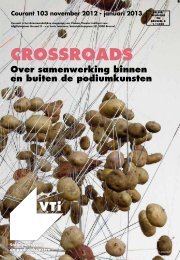music theatre in flanders - Muziekcentrum Vlaanderen
music theatre in flanders - Muziekcentrum Vlaanderen
music theatre in flanders - Muziekcentrum Vlaanderen
Create successful ePaper yourself
Turn your PDF publications into a flip-book with our unique Google optimized e-Paper software.
Diagram 3: Number of producers per production (for <strong>music</strong><br />
<strong>theatre</strong> only)<br />
500<br />
375<br />
250<br />
125<br />
0<br />
5 of meer<br />
4<br />
3<br />
2<br />
1993-1997 1997-2001 2001-2005<br />
1 177 167 177<br />
1 2 37 90 117<br />
3 16 36 82<br />
4 9 19 31<br />
5 or more 11 23 46<br />
The diagram shows that co-produc<strong>in</strong>g became an <strong>in</strong>creas<strong>in</strong>gly current<br />
practice <strong>in</strong> <strong>music</strong> <strong>theatre</strong> dur<strong>in</strong>g the period of the Perform<strong>in</strong>g<br />
Arts Decree. In 1993-1997 the majority of productions – 71% to be<br />
precise – were still taken care of by one s<strong>in</strong>gle organization. Dur<strong>in</strong>g<br />
the period 2001-2005, this percentage went down to a mere 39%.<br />
When compar<strong>in</strong>g this diagram to the data concern<strong>in</strong>g the entirety<br />
of the perform<strong>in</strong>g arts (as published <strong>in</strong> Metamorphoses), it<br />
is clear that th<strong>in</strong>gs evolved more quickly <strong>in</strong> <strong>music</strong> <strong>theatre</strong> than <strong>in</strong><br />
the perform<strong>in</strong>g arts <strong>in</strong> general. In the perform<strong>in</strong>g arts, the general<br />
number of productions made by one s<strong>in</strong>gle producer decreases<br />
from 80% (dur<strong>in</strong>g the period 1993-1997) over 64% (<strong>in</strong> 1997-2001)<br />
to 52% (<strong>in</strong> 2001-2005). In <strong>music</strong> <strong>theatre</strong>, as we noted above, the<br />
number decreases from 71%, over 50%, to 39%. In other words:<br />
there is a difference <strong>in</strong> pace <strong>in</strong> co-production practice between<br />
<strong>music</strong> <strong>theatre</strong> production and the perform<strong>in</strong>g arts <strong>in</strong> general.<br />
Moreover, there is a remarkable analogy <strong>in</strong> dance, where th<strong>in</strong>gs<br />
proved to evolve even more quickly: <strong>in</strong> 2001-2005 less than a third<br />
of the productions was made by one s<strong>in</strong>gle company.<br />
Why is there so much co-operation <strong>in</strong> <strong>music</strong> <strong>theatre</strong>? There<br />
are artistic as well as economic reasons. Music <strong>theatre</strong> production<br />
is <strong>in</strong>terdiscipl<strong>in</strong>ary by def<strong>in</strong>ition and requires the comb<strong>in</strong>ation<br />
of very specific artistic competences and skills. Co-operation<br />
can be meant to br<strong>in</strong>g together partners who have very different<br />
forms of expertise. 2 For The Woman Who Walked <strong>in</strong>to Doors, for<br />
<strong>in</strong>stance, LOD and RO Theater worked together with The Royal<br />
Monnaie and De Filmfabriek.<br />
But economic necessity also plays an important part. It is<br />
def<strong>in</strong>itely not a co<strong>in</strong>cidence that there is more co-operation <strong>in</strong><br />
dance and <strong>music</strong> <strong>theatre</strong> than <strong>in</strong> the other perform<strong>in</strong>g arts. What<br />
both sub-discipl<strong>in</strong>es have <strong>in</strong> common is that they are relatively<br />
expensive, labour-<strong>in</strong>tensive perform<strong>in</strong>g arts discipl<strong>in</strong>es. For <strong>music</strong><br />
<strong>theatre</strong>, you often need large casts – hav<strong>in</strong>g to <strong>in</strong>volve actors<br />
and (ensembles of) s<strong>in</strong>gers/<strong>music</strong>ians, as a result of the choice<br />
of a specific repertoire,.... Work<strong>in</strong>g together opens opportunities<br />
2. The follow<strong>in</strong>g should be noted: Flyers often mention the contribution of<br />
<strong>music</strong> ensembles not as ‘co-production’ but as an addition to the cast (e.g.<br />
‘<strong>music</strong> performance: Ictus’).<br />
22 23<br />
table of contents


